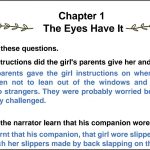“The Eyes Have It,” also known as “The Girl on the Train,” is a short story by Ruskin Bond. It tells the tale of a blind man’s journey in a train compartment, where he encounters a mysterious girl. This story explores themes of perception, deception, and human interaction.
Question
What is the central theme of “The Eyes Have It”?
Answer
The central theme of “The Eyes Have It” is perception versus reality, highlighting how people often perceive things differently than they are.
Question
Who is the author of “The Eyes Have It”?
Answer
The author of “The Eyes Have It” is Ruskin Bond.
Question
Why is the story also known as “The Girl on the Train”?
Answer
It is also known as “The Girl on the Train” because the story revolves around a blind man’s encounter with a mysterious girl during a train journey.
Question
What is the story’s setting?
Answer
The story is set in a train compartment during a journey from Rohana to Dehra.
Question
How does the narrator perceive the girl in the story?
Answer
The narrator perceives the girl as beautiful, based on her voice and fragrance, despite being blind.
Question
What does the narrator learn about the girl at the end of the story?
Answer
At the end of the story, the narrator learns that the girl is also blind.
Question
How does the author use irony in the story?
Answer
Irony is used when both the narrator and the girl are unaware of each other’s blindness throughout their conversation.
Question
What is the significance of the title “The Eyes Have It”?
Answer
The title signifies the importance of vision, or the lack of it, in the story, focusing on how the characters “see” things differently.
Question
What does the blind man’s interaction with the girl reveal?
Answer
It reveals that physical sight is not the only way to understand or appreciate beauty; sometimes, it’s the inner senses that provide deeper insights.
Question
Why is the story considered a classic?
Answer
The story is considered a classic because of its simplicity, unexpected twist, and exploration of human nature and perception.
Question
What makes the ending of the story surprising?
Answer
The ending is surprising because the narrator, who is blind, learns that the girl he had imagined to be sighted is also blind.
Question
What does the narrator try to hide from the girl?
Answer
The narrator tries to hide his blindness from the girl during their conversation.
Question
How does the author build suspense in the story?
Answer
The author builds suspense by keeping the reader unaware of the characters’ blindness until the end.
Question
Why does the narrator feel that he can deceive the girl?
Answer
The narrator believes he can deceive the girl because he is confident in his conversational skills and ability to act normal.
Question
How does the story reflect the author’s writing style?
Answer
The story reflects Ruskin Bond’s writing style, characterized by simplicity, vivid imagery, and a subtle twist at the end.
Question
What does the girl’s perfume symbolize in the story?
Answer
The girl’s perfume symbolizes her presence and beauty, which the blind narrator perceives through his other senses.
Question
What does the conversation between the narrator and the girl reveal?
Answer
The conversation reveals both characters’ efforts to present themselves confidently, despite their hidden disabilities.
Question
How does the narrator describe the girl’s voice?
Answer
The narrator describes the girl’s voice as melodious and sweet, which he finds attractive.
Question
What lesson does the story impart about human interactions?
Answer
The story imparts that true understanding in human interactions goes beyond physical appearance and relies on deeper perception.
Question
Why is the story popular among readers?
Answer
The story is popular for its engaging plot, unexpected twist, and exploration of human perception and deception.
Question
How does Ruskin Bond use symbolism in the story?
Answer
Ruskin Bond uses symbolism through the “eyes,” representing perception and the idea that seeing is not always believing.
Question
What is the climax of “The Eyes Have It”?
Answer
The climax occurs when the narrator learns about the girl’s blindness from another passenger after she has left the compartment.
Question
Why does the narrator feel proud of his deception?
Answer
The narrator feels proud because he believes he successfully concealed his blindness and kept the conversation normal.
Question
What role does imagination play in the story?
Answer
Imagination plays a crucial role as both the narrator and the reader imagine the girl’s appearance based on her voice and perfume.
Question
How does the author convey the themes of perception and reality?
Answer
The author conveys these themes by illustrating how both the blind man and the girl perceive each other based on limited senses, ultimately revealing that both are blind.
Question
What impact does the twist at the end have on readers?
Answer
The twist at the end surprises readers and forces them to reconsider their own perceptions, similar to the characters.
Question
What is the narrator’s reaction to the revelation at the end?
Answer
The narrator is stunned and left in disbelief when he discovers that the girl was also blind.
Question
How does the story challenge stereotypes about blindness?
Answer
The story challenges stereotypes by depicting blind individuals as intelligent, confident, and capable of engaging in normal conversations.
Question
Why does the girl hesitate to share details about her appearance?
Answer
The girl may hesitate because, like the narrator, she is trying to avoid revealing her blindness.
Question
What does the narrator’s experience reveal about human nature?
Answer
The narrator’s experience reveals that humans often rely on assumptions and can be easily deceived by their perceptions.
Question
What literary devices are used in “The Eyes Have It”?
Answer
Literary devices include irony, symbolism, suspense, and imagery to enhance the narrative and themes.
Question
How does the narrator try to impress the girl?
Answer
The narrator tries to impress the girl by confidently engaging her in conversation and pretending to notice things he cannot see.
Question
What role does the setting play in the story?
Answer
The train setting provides a confined space, creating intimacy between the characters while also emphasizing their isolation due to blindness.
Question
How does the narrator describe the hills?
Answer
The narrator describes the hills poetically, using his imagination and memory to create a vivid image of their beauty.
Question
Why is the narrator interested in the girl’s physical appearance?
Answer
The narrator is interested in the girl’s appearance out of curiosity and a desire to imagine what he cannot see.
Question
How does the girl’s blindness remain concealed during the conversation?
Answer
The girl’s blindness remains concealed because she speaks confidently and avoids any mention of it, much like the narrator.
Question
What is the moral of the story?
Answer
The moral of the story is that appearances can be deceptive, and true understanding comes from perceiving beyond the surface.
Question
How does the narrator’s blindness influence the story?
Answer
The narrator’s blindness shapes the narrative, as it influences his interactions, perceptions, and the eventual twist at the end.
Question
What message does Ruskin Bond convey through the story?
Answer
Ruskin Bond conveys the message that sight is not the only way to experience life, as inner perception is equally important.
Question
How does the narrator feel when the girl leaves the compartment?
Answer
The narrator feels a sense of loss and disappointment as he enjoyed her company and the conversation.
Question
What is the significance of the train journey?
Answer
The train journey symbolizes the journey of life, where people encounter each other briefly and may not see things as they truly are.
Question
How does the narrator use his other senses to understand the girl?
Answer
The narrator uses his sense of smell and hearing to perceive the girl’s presence and beauty.
Question
What does the story reveal about the narrator’s personality?
Answer
The story reveals that the narrator is intelligent, imaginative, and has a sense of humor despite his blindness.
Question
What role does the other passenger play at the end of the story?
Answer
The other passenger plays the role of a revealer, disclosing the girl’s blindness to the narrator.
Question
How does Ruskin Bond create a sense of mystery in the story?
Answer
Ruskin Bond creates mystery by withholding information about the characters’ blindness until the end, keeping readers intrigued.
Question
Why does the narrator enjoy traveling alone?
Answer
The narrator enjoys traveling alone because it allows him to use his imagination freely without interference.
Latest Posts
- Step-by-step guide to download and apply for jee mains admit card 202
- Comprehensive 2025 government holidays and recruitment details for job seekers
- JEE Mains Admit Card 2025: Your Step-by-Step Guide to Downloading the Hall Ticket
- Everything You Need to Know About 2025 Government Holidays Recruitment
- Comprehensive Guide to rrb d group recruitment 2025 – Eligibility, Vacancies, and Application
- Detailed guide to nps trust recruitment 2025 vacancies, eligibility and apply process
- Comprehensive guide to hpcl recruitment 2025 notification, vacancies, and application process
- ignou bed admission 2025 complete recruitment guide with eligibility and process
- Comprehensive Guide to Indian Army Agniveer Recruitment 2025 Notification and Jobs
- Everything You Must Know About CBSE Board Exams 2025 Changes & New Rules



